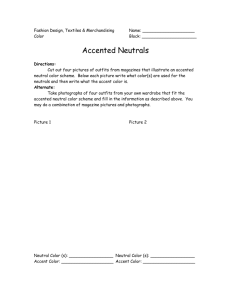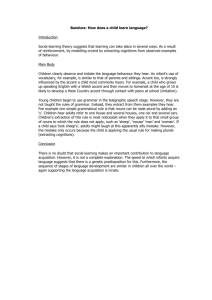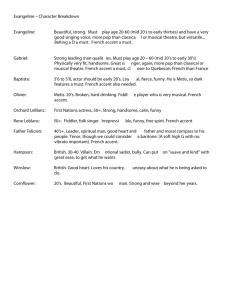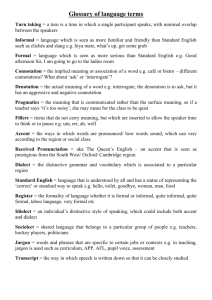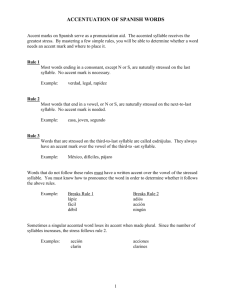Types of focus in English
advertisement
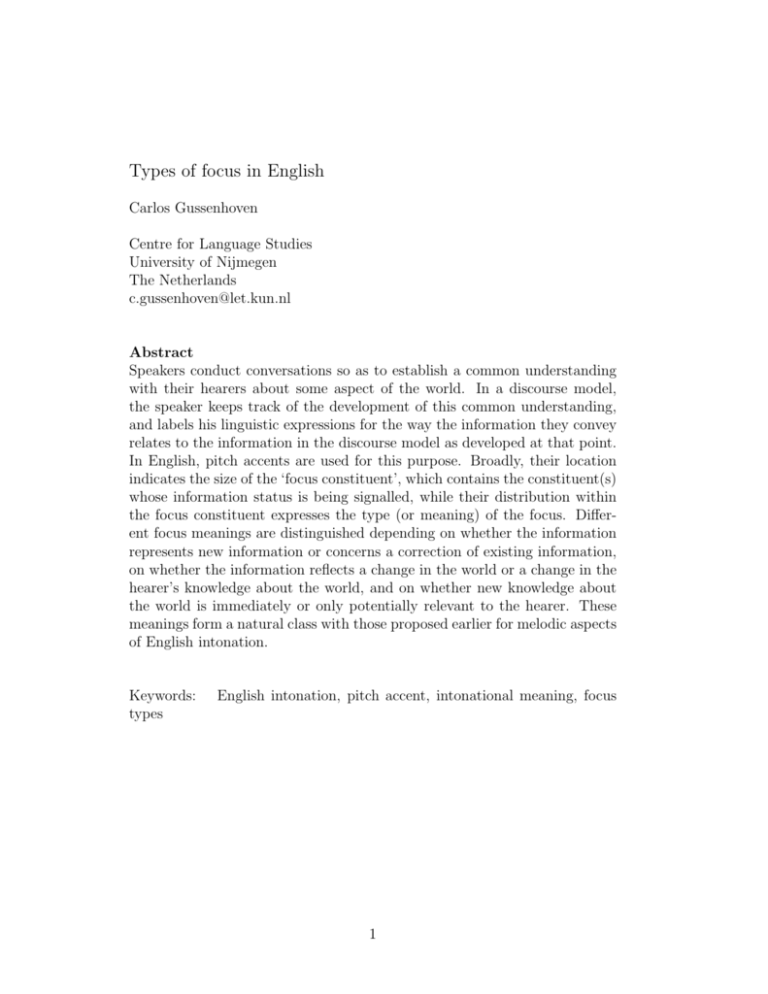
Types of focus in English Carlos Gussenhoven Centre for Language Studies University of Nijmegen The Netherlands c.gussenhoven@let.kun.nl Abstract Speakers conduct conversations so as to establish a common understanding with their hearers about some aspect of the world. In a discourse model, the speaker keeps track of the development of this common understanding, and labels his linguistic expressions for the way the information they convey relates to the information in the discourse model as developed at that point. In English, pitch accents are used for this purpose. Broadly, their location indicates the size of the ‘focus constituent’, which contains the constituent(s) whose information status is being signalled, while their distribution within the focus constituent expresses the type (or meaning) of the focus. Different focus meanings are distinguished depending on whether the information represents new information or concerns a correction of existing information, on whether the information reflects a change in the world or a change in the hearer’s knowledge about the world, and on whether new knowledge about the world is immediately or only potentially relevant to the hearer. These meanings form a natural class with those proposed earlier for melodic aspects of English intonation. Keywords: types English intonation, pitch accent, intonational meaning, focus 1 Introduction This chapter has two aims. First, section 0.1 intends to shows that the way pitch accents express information structure in English is subject to structural constraints. This view is contrasted with one in which the pitch accent directly signals the information status of the word it occurs on. The second aim, pursued in section 0.2, is to show that there isn’t just a single semantic contrast between ‘old’ and ‘new’ information: languages express various kinds of focus meanings, ranging form reactivating focus to corrective focus. 0.1 The expression of focus by means of pitch accents in English Intuitively, pitch accents in English indicate that the speaker means to stress the importance of the words they appear on. Recapitulating earlier research, this section endorses a research tradition in which this intuition is undermined by the demonstration that there are structural constraints on the way pitch accents signal the focus constituent of the sentence. That is, the connection between the pitch accent and pragmatic ‘importance’ is not word-based. Depending on the syntactic structure, an accented word may signal the focus of a larger constituent than that formed by word on its own. Before exploring the role of the syntactic structure in determining the relation between accentuation and the focus constituent, the alternative, ‘direct’ position is presented as a background. Generally, speakers conduct conversations so as to establish a common understanding about some aspect of the world. They keep track of the development of their common understanding in a ‘discourse model’, and indicate the way their information relates to the hearer’s understanding. Pitch accents express this ‘information status’. The focus constituent may, in Ladd’s (1980, p. 77) terminology, be ‘broad’ or ‘narrow’, depending on size. If a speaker takes someone to task for making a pedantic remark, the sentence Even a nineteeth-century professor of CLASSics wouldn’t have allowed himself to be so pedantic contains a relatively broad focus on a nineteenth-century professor of classics. In Ladd’s words, the addressee here ‘has nothing to do with classics, is not a professor, and is more or less contemporary’, and a nineteethcentury professor of classics just so happens to be the most pedantic type of person the speaker could think of. However, if the speaker were trying to come up with what to him is a particularly clear case of nineteeth-century pedantry, the focus would be narrowed down to professor of classics, while 2 the focus would be narrowed down further to just classics if the discussion was more specifically about pedantry among nineteenth-century professors. The variation between ‘broad’ and ‘narrow’ focus which this example shows was earlier discussed under the rubrics of ‘normal stress’, for the ‘broadest’ case, and ‘contrastive stress’, as in other cases (where ‘stress’ is equivalent to ‘accent’) (Newman 1946; Chomsky & Halle 1986; Bresnan 1971; Bresnan 1972). This older view held that ‘normal’ accent patterns (which were never defined, but were assumed to be the most natural pattern when reading out an isolated sentence) were determined by syntactic factors, but that ‘contrastive’ accent patterns arose from independently meaningful considerations. Thus, ‘normal’ stress was believed to yield to formal linguistic rules, while ‘contrastive’ stress was not. This position came under attack by Bolinger (1972) and Schmerling (1974). Bolinger stressed that all accent placements are meaningful, and that it is impossible to draw a dividing line between ‘normal’ and ‘contrastive’ accents. In this view, all new information implicitly contrasts with other information: the sentence I’ll give you a BOOK does not change its structure if the implication changes from ‘I won’t give you a cd-rom’ to ‘I won’t give you anything else’, or even to ‘I won’t behave in any other way’. These differences are gradient and non-structural, Bolinger argued (1972), and in all three cases the accent location is determined by the speaker’s informational bias towards the concept ‘book’. Bolinger’s main point that ‘neutral’ and ‘contrastive’ accentuations should be explained within a single conception of information structure was welcomed by later researchers (Schmerling 1974; Ladd 1980; Gussenhoven 1983a; Selkirk 1984). His position was otherwise vulnerable on two counts, however. One is that ‘contrastive’ focus may actually be expressed differently from ‘neutral’ focus. In fact, when looking at languages other than English, these differences turn out to be of two kinds. First, ‘contrastive’ may refer to a type of focus, to be discussed as ‘corrective’ focus in section 0.2. Even if English does not always distinguish between ‘presentational focus’ (Zubizarreta 1998; Selkirk 2002) (or ‘information focus’ Kiss (1998)) and corrective focus, some languages, like European Portuguese, consistently use different forms (Frota 1998). In such cases, the equivalents of (1a) and (1b) are not homophonous. (1) a. (A: Has she driven any other cars besides Fords and Chevrolets?) B: She used to drive [a RENault CLIO]FOC b. (A: Helen used to drive a Ford Capri) B: No, she used to drive [a RENault CLIO]FOC Second, some languages appear to make a distinction between broad focus, 3 in which there is no particular constituent which is focused (or, alternatively, the entire expression in considered the focus constituent) and narrow focus. For instance, Bengali has different pitch accents in cases equivalent to (2a) and (2b) (Hayes & Lahiri 1991). In such cases, the term ‘neutral’ is applied to the broad-focus form. (2) a. (A: What else can you tell us about Helen?) B: She [used to drive a Renault CLIO]FOC b. (A: What kind of Renault did she drive?) B: She used to drive a Renault [CLIO]FOC The other element in Bolinger’s position to be challenged is more directly relevant to English. It was the belief that a pitch accent highlighted the informational value of just the word it is placed on. Bolinger (1985, 1987) insisted that the relation between accent and focus was direct, rejecting what is known as focus projection, the ability of an accented word to signal the focus for a higher constituent, like the phrase or clause, causing differently sized focus constituents to have the same form (Chomsky 1971; Jackendoff 1972; Selkirk 1984). Such ‘focus ambiguity’ is excluded under Bolinger’s direct view of the relation between accent and focus, but almost inherently part of approaches which see the ‘focus-to-accent’ relation, a term introduced in Gussenhoven (1985), as indirect, and mediated by the linguistic structure. The structural nature of accentuation in English in fact stretches all the way from the lexicon to the sentence. The phonology determines that in the adjective MANifest the accent is on the first syllable. Morphological formations impose accentuation patterns, as in SaTANic, where the adjectival suffix causes the accent to be on the second syllable of the stem (cf. SAtan), or in LANguage consultant, where consultant is unaccented because it is the second constituent of a compound. (Burzio 1994, Hayes 1995, Zonneveld, Trommelen, Jessen, Rice, Bruce, & Árnason 1999, and references therein.) Post-lexically, the phonology determines the ‘shifted’ location of the pitch accent in the adjective in CHInese LANtern (cf. It’s ChiNESE). Schmerling (1974) pointed to a further regularity at the level of the syntax, which requires a predicate to be unaccented when paired with its subject or object in what she called ‘news sentences’, i.e. when the focus is broad. Thus, while Schmerling agreed with Bolinger on the untenability of the distinction between ‘contrastive’ stress and ‘normal’ stress, she disagreed on the role of structure. Her work formed the basis of accounts of the focus-accent relation that rely on predicate-argument structure (Gussenhoven 1978, 1983a, 1999b, 1999a; Ladd 1983; Selkirk 1984, 1995). Ladd (1980) also emphasized the 4 structural nature of accent distributions, but related the fact that the verb often goes without an accent to a scale of accentability applying to word classes. However, he endorsed my 1983 proposal in Ladd (1983). Bolinger continued to argue for the conflation of the syntactic regularity - and indeed that of the regularity expressed by Compound Stress - with deaccenting due to absence of focus (Bolinger 1972, 1978, 1985, 1989). 0.1.1 The Focus-to-Accent relation in English: SAAR The central observation is that English predicates that are surface-adjacent to an accented argument need not be accented in order to be interpreted as focused (Schmerling 1974; Gussenhoven 1983a; Gussenhoven 1992; Selkirk 1984; Selkirk 1995).1 Importantly, Schmerling observed that by the side of the SV ‘news sentence’ with its unaccented verb, (3), an unaccented predicate also appears after a non-subject argument, as in (4). Accordingly, she formulated a principle stating that, in news sentences, accents go to the argument (the subject and the object), but not to the predicate. Thus, the lack of accent on died and grow has the same explanation, as has the lack of accent on hit in (5). (All examples from Schmerling (1976)). (3) JOHNSON died (4) Great oaks from little ACORNS grow (5) JOHN hit BILL As I pointed out in a review of her book, Schmerling’s principle really extends to all (presentational focus) sentences, provided the notion of ‘focus’ is brought in. To account for the accentual pattern in her (6), she introduced the ‘Topic-comment’ sentence, and formulated the principle that in such sentences, both topic Truman and comment died are accented. This is incorrect to the extent that when we reverse topic and comment, the topic Truman remains unaccented, as in (6b), from Gussenhoven (1978). (6) a. TRUMAN DIED 1 One difference between my account and Selkirk’s theory is that the latter contains two indirectness relations rather than one. First, there is a relation between ‘focus interpretation’ and ‘F-marked constituent’ (the focus constituent), and second one between the F-marked constituent and accent distribution. While in my account the first relation is trivial in the sense that the interpretation of each focus constituent is that it is focused, and thus ‘new’, in Selkirk’s theory, focus interpretation principles are applied to the focus constituent so as to establish which parts in it are interpreted as ‘new’ and which as ‘given’. See also Gussenhoven (1999a). 5 b. The disease KILLED Truman If we assume that ‘topic’ means ‘outside the focus’, things fall into place. Comments are accented, topics are not; the reason why the topic in (6a) is accented is due to its position before the focus, where accents are optional. Not only do we now account for (6a) and (6b), we can also generalize the instruction ‘accent the comment’. Subjects and objects are ‘arguments’, as noted by Schmerling. That is, they represent necessary elements in the semantics of the predicate, and as such contrast with constituents that express circumstantial conditions on the predicate, like time, space and manner adjuncts, henceforth ‘modifiers’. What Schmerling’s principle amounts to is that any focused argument, predicate or modifier forms its own comment, except the special case of the single comment formed by a predicate that is adjacent to one of its arguments. The argument-predicate connection seems especially clear from cases like (7a,b). Since direction adjuncts are arguments of verbs of motion, as in (7a), no accent appears on the verb taken, but in (7b), where the verb bury appears in combination with a place adjunct, there are two ‘comments’, and two accents appear. The fact that Independence occurs in a Prepositional Phrase in both cases is immaterial. (Truman, again, is a topic.) Following Schmerling’s strategy to employ German to demonstrate the same regularities in a language with a different word order, the Dutch translations bring out the difference more clearly (Gussenhoven 1978). (7) a. Truman Truman b. Truman Truman was taken to INDEPENDENCE werd naar INDEPENDENCE gebracht was BURIED in INDEPENDENCE werd in INDEPENDENCE BEGRAVEN The ‘comments’ were relabelled ‘focus domains’ in Gussenhoven (1983a), to mean constituents that can be placed in focus by the accentuation of only one word, and the generalization was given the status of a Sentence Accent Assignment Rule (SAAR). It is comparable to the Compound Rule, which deletes accents on the second constituent of compounds, but operates at a higher level of structure: a predicate loses its accent when an adjacent accent appears on one of its arguments. While the next paragraph discusses the way SAAR applies in complex sentences, the structural nature of the relation can be shown in a number of ways even within the clause. Interruption of the adjacency of predicate and argument by an accented modifier breaks up the focus domain, causing the predicate to be accented, as in (8c), which is to be compared with the uninterrupted focus domain in (8a) and with the intervening unaccented time modifier just in (8b). 6 (8) a. [My TYRES have been cut]FOC b. [My TYRES have just been cut]FOC ‘only a little while ago’ c. [My TYRES have JUST been CUT]FOC ‘without further ado’ Second, the fact that the semantically similar (9a) and (9b), from Gussenhoven (1985), have accentuations that follow SAAR, not the semantics. (9) a. [Your TROUSers are torn]FOC b. [There’s a TEAR in your trousers]FOC Third, the argument must have its head in focus. The focus constituent in (10a) is black, and since the noun bird is outside it, the predicate cannot be deaccented. By contrast, in (10b) the noun blackbird is included in the focus constituent, and the pattern goes through. Both examples could be answers to a question about the well-being of a group of birds, but only (10a) can count as a straightforward answer. Example (10b) carries an implication of some awkward downplaying of the fact that one of the birds has escaped (Gussenhoven 1985). (10) a. ??The [BLACK]FOC bird [has escaped]FOC (Cf. The BLACK bird has ESCAPED) b. [The BLACKBIRD has escaped]FOC Fourth, complex predicates behave like predicates. These include ‘natural predicates’ like take advantage of, pay attention to, which Di Sciullo & Williams (1987) argue are syntactically atomic. This explains why we can have (11a), but not (11b). They support the syntactic difference between these structure by pointing out that (11b) is in fact grammatically ill-formed, quite regardless of how it is accented. That is, take great advantage of is not a multi-word verb, like take advantage of, but a syntactic phrase. (11) a. [ BILL’s been taken advantage of]FOC b. ?[ BILL has been taken great advantage of]FOC In Selkirk 1984, 1995, focus projection continues to higher levels of structure, like the VP and the S. In my view of focus projection, only predicate focus can be licensed by an accent on an argument. In fact, there is a further restriction to be stipulated, which is that subjects can only license focus on the predicate if no further lexical constituents follow. That is, Her HUSband beats the poor soul is not a well-formed reply to Why has SHE come to this family refuge centre?, while Her HUSband beats her is. In effect, the legitimate argument-predicate focus domains are as in (12). (12) Possible predicate-argument focus domains: [SUBJ-pred]]S, [pred-OBJ] 7 0.1.2 SAAR in complex sentences In complex sentences, SAAR applies as often as there are clause nodes in the expression (Gussenhoven 1992). Consider the constructions in (13). (13) a. Embedded nonfinite object clause (I heard a clock tick) b. Embedded nonfinite object clause plus indirect object (I forced a clock to tick) c. Resultative (I’ve painted the door green) d. Depictive (I drank the coffee cold) In (13a), a nonfinite clause a clock tick functions as the argument of heard in the main clause. SAAR requires that within the nonfinite clause, the argument a clock is accented if both it and its predicate tick are included in the focus constituent. This is shown in (14). In the main clause, the requirement is that the argument a clock tick is accented and its predicate heard unaccented, if both constituents are included in the focus constituent. Since the argument is accented, on clock, the condition has been met. The accent on clock thus functions at two levels of structure, once at the level of a clock (tick) and once at the level of (heard) a clock tick. In the same way, lion and a lamb are arguments of the predicate devour in (15). At the higher level, the requirement that a lion devour a lamb, the argument of saw, is accented is now met through the presence of two accents. (14) I [heard a clock tick]FOC (I) [heard]P red [[a CLOCK]Arg [tick]P red ]Arg (15) I [saw a lion devour a lambFOC (I) [saw]P red [[a LION]Arg [devour]P red [a LAMB]Arg ]Arg The structure of (13b) differs from (13a) in that the predicate (e.g. force, promise, teach, tell) takes three arguments rather than two. In (13b), there is an object to tick and an indirect object a clock, in addition to the subject. The latter licenses the unaccented predicate forced, while to tick forms its own focus domain. Therefore, two accents appear in (16). When the direct object is a clause, as in (17), SAAR applies within it: the argument devour a lamb is a clause, which has an accent on the argument a lamb and leaves the predicate devour unaccented. (16) I [forced a clock to tick]FOC (I) [forced]P red [a CLOCK]Arg [[[to TICK]P red ]S ]Arg 8 (17) I [taught a lion to devour a lamb]FOC I [taught]P red [a LION]Arg [[[to devour]P red [a LAMB]Arg ]S ]Arg Selkirk (1995) offers an alternative explanation for the difference between (13a) and (13b), which relies on the presence of a subject trace for the verb to tick in (13a), as shown in (18a). Assuming that a pitch accent in any event licenses focus on the word it occurs on, her syntactic theory of focus projection, which also builds on Rochemont (1984), postulates three projection relations that license focus for higher constituents. First, heads license focus on phrases; second, objects (i.e. internal arguments) license focus of the head; and three, moved constituents license their trace (Selkirk 1995). Because subjects are assumed to be raised from their clause, they leave a trace which is focus if the subject is focus, and the trace then projects focus to the VP and ultimately to the whole clause. In effect, because a subject trace is now treated as an internal argument, this procedure equates subjects with objects for the purposes of the second projection relation. It has the additional effect of explaining why to tick in (18a) can be unaccented, and yet be focus, since (18a) has a trace, but (13b) has not, as shown in (18b), after Selkirk (1995). This theory is considerably less restrictive than the one defended here. The restriction to internal arguments in the second projection clause would appear to be rendered vacuous by the addition of the third clause. While in the original two-clause version subjects were incapable of projecting focus at all, in the three-clause version subjects can project focus to the entire clause, even in a sentence like JOHNson died of natural causes. This seems incorrect; for discussion see Gussenhoven (1999a). (18) a. [I heard [a CLOCK [[t] tick]]] b. [I forced [the CLOCK [to [PRO TICK]]] Moving to (13c,d), a summary of the syntactic analyses proposed for these constructions is provided in Winkler (1996, ch.2). Two analyses would at first sight be compatible with the accentuation facts. First, Di Sciullo & Williams (1987) analyse sentences like (13c) as containing only one clause. The special feature is the complex predicate: paint green is a single constituent, which can form a focus domain with an argument like the door, thus remaining unaccented itself. (Within the predicate, the accent goes to the adjective, just as it goes to the particle in phrasal verbs like to look up). This is shown in (19). As pointed out by someone after a presentation of these data at the 2000 LAGB meeting, this formation of complex predicates is probably subject to a size constraint, since To paint the DOOR a bright green seems ill-formed. 9 (19) I [have painted the door green]FOC (I) [have painted green]P red [the DOOR]Arg (20) (I) [have painted]P red [[the DOOR]Arg [green]P red ]Arg A second possible analysis of (19) is (20), where door would be accented because it is a theme in the small clause the door (be) green. In this analysis, (be) green is the predicate, while the small clause itself is a theme of paint. However, it can be shown that resultatives don’t behave like argumentpredicate structures. If the door green is a clause, it should be able to be a focus constituent and have just an accent on door. In (21), we see that this can be done with birds in birds sing, an undoubted clause. By contrast, (22) cannot have the same accentuation. This is explained if we assume that arguments like doors and walls do not have green, black as predicates, but paint green, paint black. Under that interpretation, green, black are headless fragments of predicates, and understandably arguments cannot form focus domains with them (cf. also (10)). (21) (A: So what have you seen in the nature reserve?) I’ve seen BIRDS fight, I’ve seen TURTLES mate, I’ve seen ELEPHANTS feed ... (22) (A: So what have you ever painted?) ?? I’ve painted DOORS green, I’ve painted WALLS black, I’ve painted FURNITURE red ... I’ve painted DOORS GREEN, I’ve painted WALLS BLACK, I’ve painted FURNITURE RED ... Resultatives contrast with depictives of the type illustrated by (13d), which is pronounced I drank the COFFEE COLD (Winkler (1996, p. 277 ff)). With respect to the predicate drank, cold functions as a modifier requiring the proposition ‘I drank the coffee’ to be valid under the condition ‘X be cold’. The possible interpretations for ‘X’ are ‘the coffee’ and ‘he’. Since cold functions as a modifier in the clause I drank the coffee, it has no argument at that level of structure with which it can form a focus domain, even though the modifier itself may well analyzed as a small clause containing just cold as a predicate. This concludes the section on the structural relation between pitch accents and information structure in English. The next section discusses different types of focus. 10 0.2 Types of focus As Dik (1980, 1997) makes clear, languages not only express information packaging in different ways, they also express different focus meanings, or ‘focus types’. In this section, I list a number of focus types that have been distinguished in English. In each case, the form is described, and the meaning informally characterized. 0.2.1 Presentational focus The term ‘focus’ is usually equivalent to ‘presentational focus’. A commonly used diagnostic is questioning: the focus constituent is the part of the sentence that corresponds to the answer to a question, either overt or implied (Kanerva 1989). In the preceding section, many examples were given. 0.2.2 Corrective focus When the focus marks a constituent that is a direct rejection of an alternative, either spoken by the speaker himself (‘Not A, but B’) or by the hearer, the focus is ‘corrective’ (or ‘counterassertive’ cf. Dik 1980; Gussenhoven 1983a). As explained in section 0.1, this type is commonly referred to as ‘contrastive’, as in Chafe (1974), which term is however ambiguous, as it may also refer to ‘narrow focus’. English bans pitch accents to the right of the presentational focus within the intonational phrase, but to the left of the focus, pitch accents are commonly used, as in (23a). However, with corrective focus, deaccentuation would equally seem appropriate before the focus constituent, as illustrated in (23b). (23) a. (A: What’s the capital of Finland?) B: The CAPital of FINland is [HELsinki]FOC b. (A: The capital of Finland is OSlo) B: (NO.) The capital of Finland is [HELsinki]CORRECTIVE Languages that make a formal distinction between presentational focus and corrective focus include Efik, where a focused answer to a WH-question is not expressed in the same way as a focused correction, which requires a corrective focus particle (de Jong 1980; Gussenhoven 1983a). Lekeitio Basque, too, expresses corrective focus and presentational focus differently (Elordieta, this volume). Navajo has a neutral negative, doo ... da, shown in (24a), and one that expresses corrective focus, hanii, as shown in (24b,c) (Schauber 1978). The acute indicates high tone. 11 (24) 0.2.3 a. Jáan doo chidí yiyííÃlcho̧’-da John neg car 3rd-past-wreck-neg ‘John didn’t wreck the car’ b. Jáan hanii chidí yiyííÃlcho̧’ John neg car 3rd-past-wreck ‘JOHN didn’t wreck the car (someone else did)’ c. Jáan chidí hanii yiyííÃlcho̧’ ‘John didn’t wreck the CAR (he wrecked something else)’ Counterpresupposition focus A third type, which may be rare, is ‘counterpresuppositional’ focus, which involves a correction of information which the speaker detects in the hearer’s discourse model. English has a special form for counterpresuppositional focus if the focus constituent is the polarity of the sentence. In (25a), originally from Ladd (1980, 87), the focus is on the negation, while John reads book is the background. If the focus had been ‘corrective’, i.e. been a correction of new information brought in by a preceding utterance, the expression would have been (25b), which has corrective focus on the negation.2 (25) a. (A: Has John read Slaughterhouse Five?) B: John does [n’t]COUNTERPRESUP READ books b. (A: I’m telling you: John reads books!) B: I’m sorry, John does [NOT]CORRECTIVE/DOES[n’t]CORRECTIVE read books English counterpresuppositional polarity focus may be expressed by means of a pitch accent on a preposition in a non-focused constituent. Such accentuation of prepositions should be distinguished from (presentational or correction) focus for the preposition itself. Example (26a) contrasts with (26b) in this way (Gussenhoven 1983a). Importantly, they would have different translations in German or Dutch. (26) a. (A: What other artistes have been in your car?) B: Patty Grey was [never]COUNTERPRESUP IN my car b. Patty Grey was never [IN]CORRECTIVE my car (implying ‘but she may have been underneath it’) 2 I incorrectly analyzed (25) as having focus on the verb in Gussenhoven (1983a, note 5). The latter would indeed have the same form, but is only appropriate in some context like ‘What doesn’t John do with books?’. Ladd (1980) himself analyzed his example as having ‘default accentuation’ on the verb, his point being that the accentuation signals that books is outside the focus, rather than that read is included in it. 12 0.2.4 Definitional focus By means of ‘definitional’ focus, the speaker indicates that the information does not refer to a change in the world, but informs the hearer of attendant circumstances. While presentational focus in English subject-predicate sentences requires the predicate to be unaccented, as in (27a), a definitional focus requires accents on both constituents, as in (27b) (originally from Kraak (1970)). I termed the pattern in (27a) ‘eventive’ in Gussenhoven (1983a). Semantically, definitional focus seems special, but phonologically it is the accentuation pattern used for the eventive meaning which seems marked: the predicate is left unaccented, even though it is in the focus constituent.3 Below, I will label the semantically default type with eventive rather than plain foc. (27) a. [Your EYES are red]EVENTIVE b. [Your EYES are BLUE]DEFINITIONAL The eventive vs. definitional distinction is akin, but not identical to the distinction between ‘individual level’ and ‘stage level’ predicates (Kratzer 1996). Stage level predicates involve transient qualities, as in (27a), where the redness is due to swollen eyelids, and individual level predicates to permanent qualities, as in (27b), where blue refers to the colour of the iris. However, (28), from Gussenhoven (1983a), shows that the eventive interpretation may combine with the inherent colour interpretation. Genericity of the subject, as suggested by Diesing (1992), does not explain the pattern either. In (29a), an existential subject licenses focus on the verb, but the generic subject in (29b) does not. However, generic subjects may occur in eventive sentences, as shown by (30), which the keeper of the last dodo might have used to announce its demise, leaving his listeners to infer the death of the last dodo from his communication that none in fact survive (Gussenhoven 1983c). (28) (A: Why have you chosen me?) B: Your EYES are blue (eventive, but permanent property) (29) a. FIREMEN are available b. FIREMEN are ALTRUISTIC (30) The DOdo is extinct (eventive; but generic subject) 3 A class of ‘event’ sentences was independently identified by Cruttenden (1984) in connection with the accentuation pattern SUBJECT-predicate. My definition referred to a focus type regardless of syntax. 13 Having ruled out equations between ‘eventive’ and ‘stage level’ and between ‘eventive’ and ‘non-generic’, we would of course like to have a semantic definition of ‘eventive’ that will cover all instances of this pattern. An eventive reports a change in the world. However, there are two caveats. First, the pattern carries some additional semantic feature of ‘non-agentive’ or ‘nonvolitional’ (Faber 1987). Thus, The BAby’s crying is the expected accentuation in a reply to ‘Why are you getting up?’, but so is GRANDmother’s CRYing, where the difference appears to lie in the volitional involvement of the subject in the action of crying. Second, in a case like (28), there is no change in the world to report, as observed by Daniel Bühring (personal communication, 2003). Here, the change would appear to lies in the relevance of blue eyes for mate selection, or for this particular case of mate selection. Neither of these aspects seem at all easy to incorporate in a definition of ‘eventive’. Under definitional focus, objects retain their power to license definitional focus on the predicate. Definitional focus thus differs from eventive focus in disallowing subject-predicate domains. The accentuation of a broad-focus SOV sentence like JOURnalists report the NEWS therefore corresponds to that of an eventive A JOURnalist was reporting the NEWS. The next focus type, contingency focus, not only bans Subject-Predicate focus domains, but also Predicate-Object ones, i.e. also requires focused predicates with adjacent accented objects to be accented. The situation can be summarized as in (31). (31) Possible argument-predicate focus domains: Eventive: [SUBJ-pred]]S, [pred-OBJ] Definitional: [pred-OBJ] Contingency: - 0.2.5 Contingency focus As a fifth type, English has an accent pattern that expresses ‘contingency’ focus. As with definitional focus, the speaker indicates that the information is not about a change in the world, but defines attendant circumstances. The difference with definitional focus is that the information is presented as potentially relevant. Examples (32a,b) are from Halliday (1967, p. 38), who incorrectly explained (32a) as being due to the status of ‘dogs’ as ‘old information’. In Gussenhoven (1983a) I pointed out that dogs is in fact accented and ‘new’ in both interpretations, but that the meaning of (32a) is ‘contingency’ (‘If there are dogs, they must be carried’), while that in (32b) 14 is ‘eventive’, and implies that the speaker might be ‘worried because he had no dog’, to quote Halliday (cf. also the discussion in Ladd (1996, p. 199)). Similarly, eventive The King of FRANCE is bald carries an implication that there is a King of France which is absent from the contingency sentence the King of FRANCE is BALD (Gussenhoven 1983c). (32) a. [DOGS must be CARRIED]CONTINGENCY b. [DOGS must be carried]EVENTIVE Unlike definitional focus, contingency focus is evident in SOV structures, as illustrated in (33), where the proverbial interpretation (33a) is an example of contingency focus, and contrasts with eventive (33b). The phonetic difference with the eventive reading is less salient than in (32a,b), because of the nonfinal position of the word carrying the accent in the contingency version. The contingency of the proposition need not always be due to the conditional status of the subject. In (34a), from Gussenhoven (1983a), the object is conditional (‘If there are thieves’). The phonetic salience of the contrast is again low in English, due to non-final position of the predicate. However, in Dutch, which has the accentable part (aan) of the phrasal verb aangeven ‘report’ in final position, the difference is as salient as that in (32a,b). (33) a. [TOO many COOKS SPOIL the BROTH]CONTINGENCY b. [[TOO many COOKS spoil the BROTH]EVENTIVE (implying ‘we need to take soup off the menu’) (34) a. [The MANagement rePORTS THIEVES]CONTINGENCY Dutch: De DIRECTIE geeft DIEVEN AAN b. [The MANagement reports THIEVES]EVENTIVE (e.g. a caption for a cartoon) Dutch: De DIRECTIE geeft DIEVEN aan In broad-focus SOV structures, therefore, it is definitional and eventive that contrast with contingency, as shown in (35), where the verb is accented only in (35c). (35) a. [The HUNters were shooting ANimals]EVENTIVE b. [HUNTers shoot ANImals]DEFINITIONAL c. [These HUNTers SHOOT ANimals]CONTINGENCY (‘So don’t let your pets get near them!’) 15 In addition to the obligatory accent on the predicate, contingency sentences obligatorily accent the negator, if there is one. A three-way contrast therefore arises in negative SV structures, as shown in (36). In eventive (36a), the entire predicate is unaccented, in definitional (36b), an accent is added to the verb, and in contingency (36c), both the verb and the negation are accented. The presence of the accent on the negation is more salient in German, where it appears post-verbally, as in (37): (37a) is either eventive, which expression could be used to complain that someone doesn’t blink, in spite of an earlier agreement that he would at that point in time, or definitional, in which case it describes a state of affairs whereby someone just never blinks. Contrast these with the contingency version (37b), which is a warning just in case. (36) a. (A: What seems to be the problem?) B: [Our CUStomers aren’t admitted]EVENTIVE b. [Our CUStomers aren’t adMITted]DEFINITIONAL (‘That’s the way it is’) c. [Our CUStomers AREN’T adMITted]CONTINGENCY (‘In case you had forgotten’) (37) a. You [don’t BLINK]EVENTIVE/DEFINITIONAL German: Du ZWINKERST nicht! b. You [DON’T BLINK]CONTINGENCY German: Und du ZWINKerst NICHT!) 0.2.6 Reactivating focus Instead of, or in addition to, new information, languages may also mark old information, an option referred to as ‘reactivating focus’. The term is somewhat paradoxical, as it is the background information that is now marked for information status. (‘Focus’ is here used in the general sense of ‘structural marking of information status’) In (38), the constituent John has ‘reactivating focus’. Speaker B considers the fact that she is not just acquainted with John, but actually dislikes him, significant enough to single out the ‘given’ John by means of the syntactic device of topicalization. In English, constituents can be topicalized, giving the meaning ‘as for this constituent’. (38) (A: Does she know JOHN?) B: JOHN she DISLIKES 16 0.2.7 Identificational focus English has a syntactic device called ‘clefting’, the ‘It is X [who/that VP]’ construction, where X is the subject of VP. It would appear that clefting causes the non-clefted constituent to be reactivated information if it is accented, as in (39). Here, the implication in B’s response is that Helen’s dislike of someone had been discussed relatively recently. The clefted constituent is optionally accented. If the non-clefted constituent is unaccented, it is old information, as in (40). The clefted constituent is now obligatorily accented, and constitutes new information. It is impossible to have both clefted and non-clefted constituents contain new formation. That is, inIt is the POSTMAN who CAME either the postman or the notion of arriving must be in the context. (39) (A: Does Helen know JOHN?) B: It is John/JOHN she DISLIKES (40) [A: I wonder who she dislikes] B: It is JOHN she dislikes Clefting, therefore, presents a somewhat complex picture when viewed from the perspective of information status. Since no ready generalization arises, its meaning may not really be concerned with legitimacy or recency of information in the background. The meaning of clefting is to exhaustively identify a constituent (Szabolcsi 1981; Kiss 1998). In (41a), the focus constituent is egy kalapot ‘a hat+acc’. The meaning of this sentence differs from that in (41b), which also has egy kalapot in focus, in that (41a) entails that Mary bought nothing but a hat. By contrast, in (41b) the hat may be one of a number of items that were bought by Mary. In other words, clefting expresses identificational focus (Kiss 1998). (41) a. Mari egy kalapot nézett ki magának Mary a hat+acc picked out herself+acc ‘It was a HAT that Mary picked for herself’ b. Mari ki nézett magának egy kalapot ‘Mary picked a HAT for herself’ The meaning difference between (41a) and (41b) is brought out by a test attributed by Kiss to Szabolcsi (1981). Compare (42) with (43): (42b) is semantically incompatible with (42a), since it claims that the hat in question is the only item bought by Mary, thus denying (42a). By contrast, no such conflict arises in the case of (43a,b), even though the speaker of (43b) may 17 be accused of being parsimonious with the truth. This is true regardless of the information status of the clefted constituent. All examples could be answers to ‘What did Mary buy?’, so that the non-clefted constituents (that Mary bought) are unaccented, but they can also be placed in a context in which Mary has presentational focus and the clefted constituents are old information (in which case the examples could be answers to I wonder why no one bought a hat or a coat or a similar item of clothing). (42) a. It was a hat and coat that Mary bought b. It was a hat that Mary bought (43) a. Mary/MARY bought a HAT and a COAT b. Mary/MARY bought a HAT 0.3 Conclusion One dimension of meaning expressed by sentence-level pitch accents in languages like English concerns the size of the focus constituent, which is expressed through deaccentuation of constituents after the focus. Beginning with Schmerling (1974), researchers have found that the relation between the pitch accent and the focus is mediated through the predicate-argument structure of the sentence, which is evident from the fact that predicates remain unaccented when they abut a focused argument. In many cases, therefore, the accent on the argument is properly to be seen as an accent on the predicate-argument combination, a regularity which obtains as many times as there are clauses in the sentence. A second dimension of meaning concerns the meaning of ‘information packaging’ itself. The semantics would appear to involve a number of distinctions. • Background vs New information. This is the basic distinction which has been referred to as ‘topic’ vs ‘focus’, ‘old/given’ vs ‘new’, etc. Information that serves to further develop the discourse model was discussed as ‘presentational focus’, while ‘reactivating focus’ was used for information retrieved from the background. • Development vs Correction. If ‘development’ is the default situation whereby speakers add information to the discourse model, correction involves the removal of information. When applied to new information, it is ‘corrective focus’ and when applied to the background, it is ‘counterpresuppositional focus’. 18 • Eventive vs Non-eventive. The development of the discourse may involve reports of changes in the world, or may further define the existing world. In the former case, we have ‘eventive focus’, in the latter the focus is non-eventive. Non-eventive focus subdivides into ‘definitional’ and ‘contingency’. • Definitional vs Contingency. In both cases, the information serves to define the world, but for ‘contingency focus’ the speaker indicates that the information is only potentially relevant to the hearer’s knowledge base. The above summary suggests that the speaker indicates how the information in his expression is to be related to the hearer’s information about the mini-world about which they are together trying to reach a state of mutual understanding. The meanings of the melodic aspects of the pitch accent in English proposed in Brazil (1975) and Gussenhoven (1983b) as well as those proposed by Pierrehumbert & Hirschberg (1990) fit this type of meaning well. The former include ‘Addition’ (Brazil’s ‘Proclaiming’), used for the commitment of information to the discourse model and signalled by falling contours, and ‘Selection’ (Brazil’s ‘Referring’), used for reference to information in the background and signalled by falling-rising contours. A third meaning, ‘Testing’, signals the speaker’s inability or refusal to commit information to the discourse model, signalled by rising contours (Gussenhoven 1983b). ‘Identificational’ focus somehow doesn’t quite match these other meanings. The information that John is the only person who caught a fish, as conveyed by It’s John who caught a fish, concerns information content rather than information status. Possibly, therefore, intonation can only be used for the expression of information structure, implying that identificational focus can only be expressed through the morphology or syntax.4 4 Recent treatments which have not been covered in this survey include Lambrecht (1994), Vallduví & Engdahl (1996), Erteschik-Shir (1997), and Zubizarreta (1998). 19 Bibliography Bolinger, D. (1972). Intonation: Selected Readings. Harmondsworth: Penguin. Bolinger, D. (1978). Review of Schmerling (1976). American Journal of Computational Linguistics, 1–23. Microfiche. Bolinger, D. (1985). Two views of accent. Journal of Linguistics 21, 79– 123. Bolinger, D. (1987). More views on ‘Two Views of Accent’. In On Accent, pp. 124–146. Bloomington, IN. Reproduced by the Indiana University Linguistics Club. Bolinger, D. (1989). Intonation and its Uses. Stanford, CA: Stanford University Press. Brazil, D. (1975). Discourse Intonation I. Birmingham UK: English Language Research, Birmingham University. Bresnan, J. (1971). Sentence stress and syntactic transformations. Language 47, 257–281. Bresnan, J. (1972). Stress and syntax: A reply. Language 48, 326–342. Burzio, L. (1994). Principles of English stres. Cambridge: Cambridge University Press. Chafe, W. L. (1974). Language and consciousness. Language 50, 111–113. Chomsky, N. (1971). Deep structure, surface structure and semantic interpretation. In D. D. Steinberg and L. A. Jakobovits (Eds.), Semantics: an interdisciplinary reader in philosophy, linguistics and psychology, pp. 183–216. Cambridge, UK: Cambridge University Press. Chomsky, N. and M. Halle (1986). The Sound Pattern of English. New York: Harper and Row. Cruttenden, A. (1984). The relevance of intonational misfits. In D. Gibbon and H. Richter (Eds.), Intonation, Accent and Rhythm. Studies in Discourse Phonology, pp. 67–76. Berlin: de Gruyter. 20 de Jong, J. (1980). On the treatment of focus in functional grammar. GLOT, Leids Taalkundig Bulletin 3, 89–115. Di Sciullo, A. and E. Williams (1987). On the definition of word. Cambridge, MA: MIT Press. Diesing, M. (1992). Indefinites. Ph. D. thesis, Cambridge University. Dik, S. C. (1997). The Theory of Functional Grammar. Part 1: The Structure of the Clause. Berlin, New York: Mouton de Gruyter. Edited by Kees Hengeveld. Dik, S. C. e. a. (1980). On the typology of focus phenomena. GLOT, Leids taalkundig bulletin 3, 41–74. Erteschik-Shir, N. (1997). The Dynamics of Focus Structure. Cambridge: Cambridge University Press. Faber, D. (1987). The accentuation of intransitive sentences in English. Journal of Linguistics 23, 341–358. Frota, S. (1998). Prosody and Focus in European Portuguese. Ph. D. thesis, University of Lisbon. Published by Garland, New York, 2000. Gussenhoven, C. (1978). Review of Schmerling (1976). Dutch Quarterly Review of Anglo-American Letters (DQR) 8, 233–240. Gussenhoven, C. (1983a). Focus, mode and the nucleus. Journal of Linguistics 19, 377–417. Reprinted in Gussenhoven (1984). Gussenhoven, C. (1983b). A semantic analysis of the nuclear tones of English. Distributed by Indiana University Linguistics Club (IULC). Bloomington, Indiana. Published as chapter 6 in Gussenhoven (1984). Gussenhoven, C. (1983c). Van focus naar zinsaccent: Een regel voor de plaats van het zinsaccent in het Nederlands. GLOT 6, 131–155. English translation included as chapter 2 in Gussenhoven (1984). Gussenhoven, C. (1985). Two views of accent: A reply. Journal of Linguistics 21, 125–138. Gussenhoven, C. (1992). Sentence accents and argument structure. In I. M. Roca (Ed.), Thematic Structure: Its Role in Grammar, pp. 79–106. Berlin/New York: Foris. Gussenhoven, C. (1999a). Discreteness and gradience in intonational contrasts. Language and Speech 42, 281–305. Gussenhoven, C. (1999b). On the limits of focus projection in English. In P. Bosch and R. van der Sandt (Eds.), Focus: Linguistic, Cogni21 tive, and Computational Perspectives, pp. 43–55. Cambridge UK: Cambridge University Press. Halliday, M. A. (1967). Intonation and Grammar in British English. The Hague: Mouton. Hayes, B. (1995). Metrical Theory. Chicago: Chicago University Press. Hayes, B. and A. Lahiri (1991). Bengali intonational phonology. Natural Language and Linguistic Theory 9, 47–96. Jackendoff, R. S. (1972). Semantic interpretation in generative grammar. Cambridge, Mass.: MIT Press. Kanerva, J. M. (1989). Focus and Phrasing in Chicheŵa Phonology. Ph. D. thesis, Stanford University, Palo Alto. Kiss, K. E. (1998). Identificational focus and information focus. Language 74, 245–273. Kraak, R. (1970). Zinsaccent en syntaxis. Studia Neerlandica 4, 41–62. Kratzer, A. (1996). Stage-level and individual-level predicates. In G. N. Carlson and F. J. Pelletier (Eds.), The Generic Book, pp. 125–175. Chicago: Chicago University Press. Ladd, D. R. (1980). The Structure of Intonational Meaning: Evidence from English. Bloomington: Indiana University Press. Ladd, D. R. (1983). Phonological features of intonational peaks. Language 59, 721–759. Ladd, D. R. (1996). Intonational Phonology. Cambridge: Cambridge University Press. Lambrecht, K. (1994). Information Structure and Sentence Form. Topic, Focus, and the Mental Representation of Discourse Referents. Cambridge: Cambridge University Press. Newman, S. (1946). On the stress system of English. Word 2, 171–187. Pierrehumbert, J. B. and J. Hirschberg (1990). The meaning of intonational contours in the interpretation of discourse. In P. Cohen, J. Morgan, and M. Pollack (Eds.), Intentions in Communication, pp. 271–311. Cambridge MA: MIT Press. Rochemont, M. (1984). Focus in Generative Grammar. Amsterdam: John Benjamins. Schauber, E. (1978). A comparison of English intonation and Navajo particle placement. In D. J. Napoli (Ed.), Elements of Tone, Stress, and Intonation, pp. 144–173. Washington, DC: Georgetown University Press. 22 Schmerling, S. F. (1974). Aspects of English Sentence Stress. Austin: Texas University Press. Selkirk, E. (1984). Phonology and Syntax: The Relation between Sound and Structure. Cambridge, MA: MIT Press. Selkirk, E. (1995). Sentence prosody: Intonation, stress and phrasing. In J. Goldsmith (Ed.), The Handbook of Phonological Theory, pp. 550– 569. Oxford: Blackwell. Selkirk, E. (2002). Contrastive FOCUS vs. presentational focus: Prosodic evidence from English. In B. Bel and I. Marlien (Eds.), Speech Prosody 2002. An International Conference, Aix-en-Provence, pp. 00–00. Laboratoire Parole et Langage, CNRS and Université de Provence. Szabolcsi, A. (1981). The semantics of topic-focus articulation. In J. Groenendijk, T. Janssen, and M. Stokhof (Eds.), Formal Methods in the Study of Language, pp. 513–514. Amsterdam: University of Amsterdam, Mathematisch Centrum. Vallduví, E. and E. Engdahl (1996). The linguistic realization of information packaging. Linguistics 34, 459–519. Winkler, S. (1996). Focus and Secondary Predication. Berlin: Mouton de Gruyter. Zonneveld, W., M. Trommelen, M. Jessen, C. Rice, G. Bruce, and K. Árnason (1999). Wordstress in West-Germanic and North-Germanic languages. In H. van der Hulst (Ed.), Word Prosodic Systems in the Languages of Europe, pp. 477–603. Berlin: Mouton de Gruyter. Zubizarreta, M. L. (1998). Prosody, Focus, and Word Order. Cambridge, MA: MIT Press. 23
